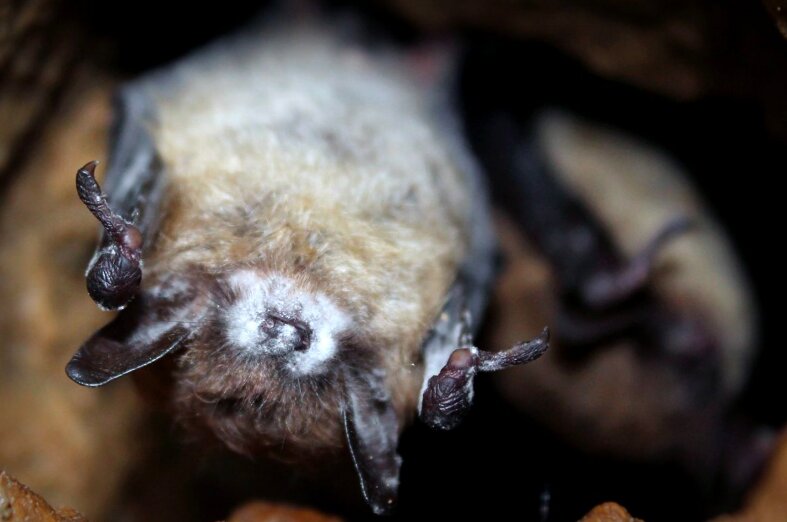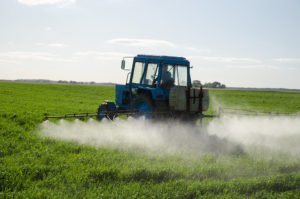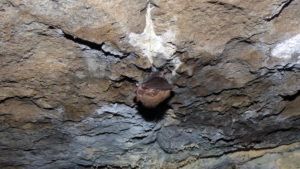
A wasting disease called white-nose syndrome has decimated Great Lakes bats over the past decade, with some species reduced by as much as 90 percent.
That’s bad news not just for the bats, but for us too – their appetite for crop and forest pests saves North American farmers billions in pesticide costs every year.

Tractor spraying field with insecticide and herbicide chemicals, Photo by Aqua Mechanical via flickr.com cc 2.0
An increase in pesticide use could be a major concern for the Great Lakes. Studies show the presence of pesticides in the St. Lawrence River watershed already exceed Canada’s environmental guidelines and increasing use of pesticides could be contributing to Lake Erie’s harmful algal bloom problem.
“The Great Lakes region is in the heat of the fire for white-nose syndrome,” said Jonathan Reichard, national coordinator for white-nose syndrome research for the U.S. Fish and Wildlife Service. “It’s where bats are experiencing the most serious declines.”
Desperate to keep this economically important animal on the landscape, scientists are now experimenting with an unusual treatment – probiotics.
Probiotics are beneficial bacteria, often found in yogurt, that can fight off disease-causing microbes in humans. There is good reason to suspect it might do the trick for endangered wildlife too.
Studies show more than a dozen bacteria that naturally occur on bat wings inhibit the growth of the fungus that causes white-nose syndrome, when tested in a petri dish. Scientists suspect most North American bats, including those in the Great Lakes, just don’t have enough of these “good” bacteria. The goal is to boost their density and crowd out the deadly fungus by spraying bats with a probiotic solution.
Putting probiotics to the test
In June, researchers with Virginia Tech and the University of California, Santa Cruz published the first field test of the strategy in a hibernating bat colony in Wisconsin infected with the fungus. Virginia Tech biologist Joseph Hoyt and his team sprayed half of the bats with a solution containing the bacterium P. fluorescens. They did not treat the other half.
Slightly more than 45 percent of bats treated with the probiotic spray survived the fungus. Less than 10 percent of the untreated bats made it.
“We’ll never be able to eradicate the fungus,” Hoyt said. But probiotics research, along with with research into an oral vaccine, anti-fungal agents and fungus-killing UV light, might hold the fungus at bay long enough for some populations to recover, he said.
Aptly known as Pseudogymnoascus destructans, the white fungal growth creeps across the creatures’ muzzles and wings as they hibernate. The disease repeatedly rouses them, burning precious fat stores and causing them to waste away. If the bats can make it to spring though, they have a decent chance of survival because P. destructans dies in warmer temperatures.

Oregon bat caves for white-nose syndrome, Photo by Bureau of Land Management Oregon and Washington via flickr.com cc 2.0
Biologists say bats in Europe, where the disease originated, have probably lived with the fungus long enough to have developed a protective coating of bacteria. Not so in North America, where white-nose syndrome was discovered in 2006 in the bat caves of eastern New York State. The disease has since spread westward across the continent to 33 states and seven provinces.
University of Winnipeg biologist Craig Willis has studied white-nose syndrome extensively and calls the probiotic work “promising.” However, Willis said a suite of different approaches will likely be needed, including helping survivors who may be genetically disposed to beat the disease. Willis said that if we can protect and perhaps enhance summertime habitat where survivors reproduce, we might help them have more and healthier babies, which will inherit their parents’ fungal-fighting genes.
“We’re seeing evidence of persisting populations in a range of places and there’s reason to think some species might be starting a bit of a rebound,” Willis said.
Featured Image: White-Nose syndrome bat, Photo by Joseph Hoyt Virginia Tech




